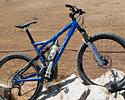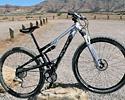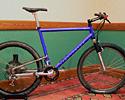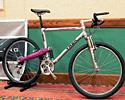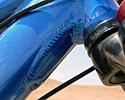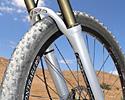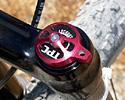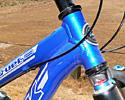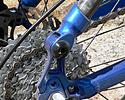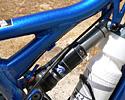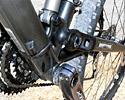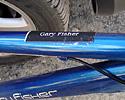
Recently on Cyclingnews.com |
Tech Feature: Trek revamps mountain bike lineup for 2007; July 7, 2006
Drawing on the past while looking to the future
Trek has spent the better part of the last decade pouring the bulk of its development resources behind the Lance Armstrong machine. Now that the party is over, some much-needed attention has been redirected to its relatively neglected mountain bike lineup. James Huang heads out to Fruita and Crested Butte, CO, to see what the giant from Waterloo has in store for the upcoming months.
For the most part, Trek's mountain bike introduction was staffed by the usual cast of characters: an assortment of product and development crew, public honchos Gary Fisher and Zapata Espinoza, as well as a variety of its professional riders, including regional pros Nick Martin (www.ridewithnickmartin.com) and Ross Schell as well as long-time team member Travis Brown, who is now heavily involved in Trek's own product development process.
However, the most significant figure on hand from Trek was Mr. Trek himself, company president John Burke. Burke's presence at the event sent a clear signal as to how important it is for Trek to regain its position in the mountain bike world. In his own words, "We've grown our business a lot in the last five years in a lot of different areas, and it's elevated Trek in the marketplace. One area of business where we haven't grown is the mountain bike business, especially when you take a look at full-suspension and serious mountain bikes. It hasn't been a big part of what we were about. We've got a really good crew here and a lot of talented people, and we haven't performed to what we think we're capable of. If you take a look at what we're introducing tonight, we've gone out there and we think we're bringing out best-in-class product. This is just the start, but it shows the future direction of the company."
To Trek's credit, the company does have a rather long and storied history in mountain bike development and it clearly wanted to remind the press as such. The presentation hall was not only littered with images of past glory, but also with physical examples of prior achievements, the highlight of which was one of Gary Fisher's own RS-1 full suspension bikes complete with then-revolutionary parallelogram linkage rear suspension. Unfortunately, also on hand was the more forgettable 9500 with its pogo-sticklike T4xC rear end, but I digress…
Heritage aside, times have changed while the company's mountain bike line mostly hasn't. However, if this latest crop of introductions is any indication, the Wisconsin company may be on the right track towards regaining some of its past prominence and fulfilling its prophecy of a "banner year for Trek and Gary Fisher mountain bikes".
New frame geometry for Gary Fisher
Gary Fisher's currently available Genesis frame geometry was introduced ten years ago in 1996. It was conceived as a way to improve the high-speed stability and descending prowess of its mountain bikes while retaining good climbing performance, but some riders felt that low-speed handling ability was sacrificed in the shuffle. Since then, the Genesis philosophy has remained largely unchanged. For '07, however, Fisher product manager Aaron Mock and his team of engineers went back to the drawing board to create Genesis 2.0 in order to address the geometry's shortcomings.
Developed in conjunction with Keith Bontrager and Manitou, the new system revolves around a custom-built Manitou suspension fork that incorporates a 46mm offset, an increase of 7mm. To counterbalance the increased fork offset, Genesis 2.0 head tubes are pulled back approximately 5mm to retain roughly the same wheelbase measurement. These changes result in the same high-speed and descending characteristics as with the original Geometry setup, but the reduced trail is said to greatly enhance its low-speed turning ability with diminished "wheel flop".
For sure, 7mm doesn't sound like much but to put things in perspective, road-going Moto GP riders can allegedly distinguish just a 6 percent change in trail. In Fisher's case, 7mm equates to a relatively huge 11 percent. Manitou will supply not just one G2-specific fork, but two: a newly updated Minute as well as an all-new Relic. Both will wear prominent "Handling by Bontrager" decals as well as the G2 logo.
Gary Fisher, now in stereo surround sound
Genesis 2.0 geometry is featured on the company's brand-new HiFi, which replaces the outgoing Cake trail bike. The new bike abandons the Cake's basic single-pivot layout in favor of a modified four-bar (or "faux bar" as there are no chainstay pivots) configuration with a linkage-activated Fox air shock that provides 120mm of rear wheel travel. In spite of the additional pivots and hardware, the HiFi frame reputedly weighs only 2378g (5.24lb) in a medium size complete with shock and hardware. Hydroforming plays a key role in the HiFi's diet plan, most notably in the heavily shaped chainstays. As with the Cake, the HiFi chainstays are asymmetric with the non-driveside stay making a beeline directly from the dropout to the main pivot in order to increase rear end stiffness while dropping weight. In addition, carbon fiber is used in the seatstays to save 60g over even the old XC-specific Sugar rear end.
Cartridge bearings are used extensively throughout the frame, including two oversized units at the main pivot, four at the seatstay-located dropout pivots, and more still at the seat tube linkage. All of the bearings are also fully press-fit for maximum surface contact area and rigidity, and the main pivot bearings are spaced very widely for better support. Word is still out on whether or not Trek plans to offer a service kit to facilitate bearing replacement in the new press-fit setups but dealers are likely to clamor for one.
Race Day now available in 29er flavors, Fat Possum now becomes just "pleasantly plump"
Jeremy Horgan-Kobelski's signature Race Day short-travel XC race-specific platform, first officially shown at this year's Sea Otter Classic, is now in full production with three different trim levels. Interestingly, the Race Day frame actually weighs just a bit more than the HiFi, with an official weight of 2406g (5.3lb)for a medium frame complete with paint and shock.
Gary Fisher continues to demonstrate its commitment to the 29er market with two 29in-wheeled Race Day variants that share the same basic attributes as the standard Race Day: 80mm of firm, single pivot travel with elevated stays, as well as a low forward pivot and narrower 68mm bottom bracket shell that facilitates a 2x9 setup.
At the other end of the spectrum, Fisher's all-mountain 150mm travel Fat Possum hasn't gone ignored in all of the XC and trail bike hoopla. The new '07 frame drops 150g from its already fairly lean profile, mostly resulting from the switch to an inline rear shock. The new chassis hits the scales at an impressive 3150g (6.94lb) for a completely painted medium frame with shock.
In part 2, we look at the upgraded Fuel bikes, Bontrager's new rims and how it all works on the trail.
Photography
For a thumbnail gallery of these images, click here
Images by James Huang/Cyclingnews
- Trek’s new HiLo chainstay assemblies allegedly save up to 200g over last year’s setups.
- Remember this? Unfortunately, the RS-1, designed by Mert Lawill and fine-tuned to perfection by Gary Fisher, was way ahead of its time and lacked component support to make it stick.
- Er… maybe Trek should have left this one at home…
- Now this is what I call a roof rack. Thought you had a stacked setup? Think again. Trek Travel’s crew can not only haul a bunch of bikes but can also arrange a mean trailside lunch.
- The new Gary Fisher HiFi sports 120mm of travel in a frame weighing under 2.4kg.
- Dropout pivots on the new HiFi are located on the seatstay instead of the chainstay (which would require a license from rival Specialized), effectively making the rear end a single pivot design.
- Even the clean downtube gusset on the HiFi is machined for weight savings.
- Fox Racing Shox’s wares gain much more prevalent spec on Trek’s lineups for ’07, particularly at the high end.
- Widely spaced oversized main pivot bearings offer good support to the rear swingarm.
- Check out the slick-looking non-driveside dropout on the HiFi. Nicely done.
- Gary Fisher worked closely with Manitou and Bontrager to develop the new Genesis 2.0 geometry. Custom-offset Manitou Minutes will grace the upper end HiFi trail bikes.
- The HiFi Pro uses a tidy-looking, bearing-equipped linkage to drive the Fox RP23 rear shock.
- CNC machines make a comeback for ’07? Interestingly enough, the new Minute crown looks awfully similar (stylistically) to my old Rock Shox SID crown!
- Trek’s top-of-the-line Fuel EX receives a new OCLV frame, substantially lighter rear end, and a wealth of premium kit including a Fox fork up front.
- New forged aluminum rockers on the Fuel EX are carved out to reduce weight yet are still fully bearing-equipped for smooth operation.
- The bottom end of the Fuel EX is particularly tidy-looking. Wide Stance main pivot bearing spacing provides better support for the rear end.
- The ’07 Fuel EX receives a proper dropout pivot to remove any built-in “springiness” from the system for more accurate suspension tuning.
- The ’07 carbon Fuel EX utilizes a one-piece top tube/head tube construction similar to that used in the roadgoing Madone.
- Upper-end Fuel EX models receive heavy suspension spec from Fox Racing Shox.
- Trek’s Top Fuel lineup now includes aluminum-framed models for the first time. Extensive hydroforming is used to shape the ZR9000 tubeset.
- No head tube gusset required here due to the careful down tube shaping.
- Trek’s Top Fuel uses new forged aluminum rocker links to drive the rear shock.
- Main pivot on the new Top Fuel receives Wide Stance bearing spacing and press-fit oversized cartridge bearings. Chainstays are asymmetric to maximum the efficient use of material.
- Manitou also receives greater OEM spec on Trek’s ’07 lineup, including the S-Type shock seen on this aluminum Top Fuel.
- Gary Fisher continues to support the 29er scene with the development of a 29in version of the Race Day short-travel XC platform.
- Simple but effective - the Supercaliber’s single-pivot rear suspension layout is primitive on paper, but proved quite capable in practice on the trail.
- Large diameter, swingarm-located cartridge bearings provide lateral support for the rear end. Narrow 68mm bottom bracket shell makes for easier 2x9 conversions and tighter q-factors.
- Rock Shox’s Reba continues to dominate the 29er fork market. Anyone else want to step up to the plate?
- Wider is better - at least as far as rims are concerned when using bigger tires. Bontrager’s new Rhythm rim measures a full 28mm wide yet still tips the scales at only 440g including eyelets.
- The top tube decal on Gary Fisher’s own test rig seemed a bit superfluous, wouldn’t you say?
- Mr. Trek made it out on the trail with us, but admitted to crashing “four and a half times”, thus explaining the dirt on his back.
- A quick transfer over to Crested Butte included a trip to the Mountain Bike Hall of Fame.

